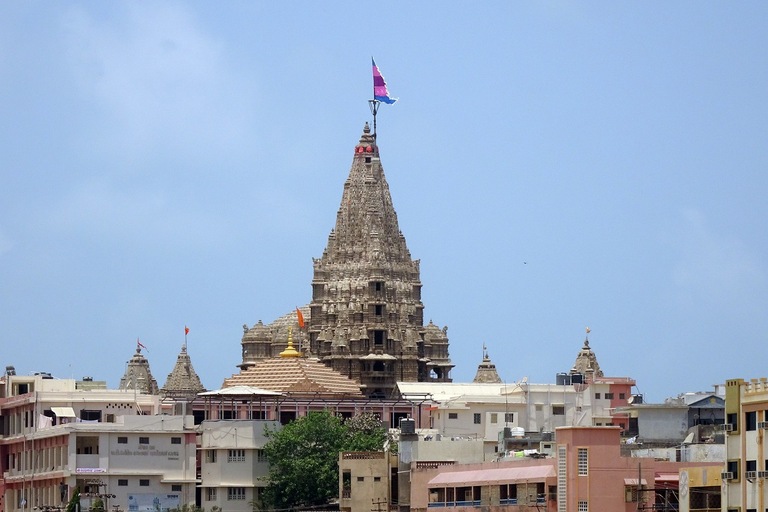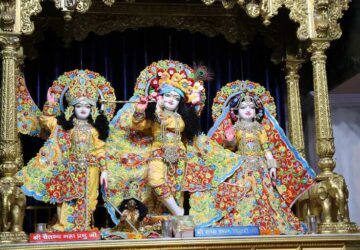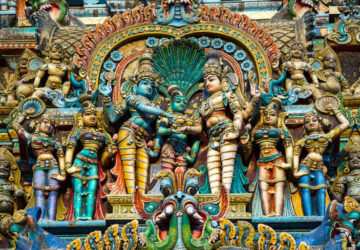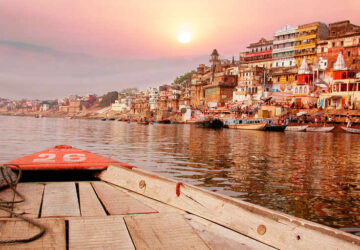
Nestled at the tip of Gujarat’s Saurashtra peninsula, Dwarka is a sacred pilgrimage site and a captivating archaeological puzzle. This city, integral to India’s religious fabric as one of the four principal holy places and a part of the illustrious seven, hides its history in veils of mystery.
The Mahabharata speaks of Dwarka as the “ancient kingdom of Krishna,” sprawling over 84 km where the Gomti River met the Arabian Sea. The lost city of Dwarka, steeped in the lore of Lord Krishna, stood on land granted by Samudra Dev and was later reclaimed upon Krishna’s celestial departure.
In the days of Dwapar Yuga, Lord Krishna established two cities, Bet Dwarka and Dwarka, around 32 km apart. While Krishna resided in Bet Dwarka, Dwarka served as the administrative hub. Today, historians and archaeologists plunge into the depths, seeking tangible proof of Krishna’s kingdom, uncovering the secrets of the fabled “Dwarka: The Lost City.”
Join us on a journey into Dwarka history, where myth and archaeology intertwine to tell a tale that transcends time.
History of Krishna’s Dwarka
Once a bustling metropolis, Dwarka and its counterpart Bet Dwarka were vibrant cities in Krishna’s time. It was adorned with palaces, temples, gardens, and more. Encircled by a protective wall, Dwarka stood as a maritime marvel with a bustling port connecting to distant lands. This was the haven where Lord Krishna chose to spend his days with queens after leaving Mathura-Vrindavan.
Dwarka, fondly known as Suvarna Dwarka (Golden Dwarka), boasted excessive use of gold, silver, gems, and precious stones in its construction. In this golden city, the Yadavas thrived in tranquillity under the benevolent rule of their beloved king, Lord Krishna.
The echoes of Dwarka’s history resonate through time, narrating tales of prosperity, architectural splendour, and the harmonious existence of its people.
Reason Behind the Establishment of The Dwarka: Lost City
According to the sacred Shrimad Bhagavatam, the genesis of Dwarka, the city of wonders, lies in Lord Krishna’s strategic move to counter Jarasandha’s constant attacks on Mathura. Seeking a haven to shield his clan, Lord Krishna, with the architectural prowess of Vishwakarma, established Dwarka on India’s western coast near Kushasthali. The city swiftly ascended to eminence, becoming the epicentre of Lord Krishna’s mission, adorned with around 900 palaces and heavily fortified against invasions, reachable only by ship.
Yet, the Mahabharata recounts a poignant twist in Dwarka’s fate. On the day Krishna left Earth after 125 years, Dwarka succumbed to the Arabian Sea, marking the onset of the Kali Yuga. The ocean reclaimed the land, submerging the city but intriguingly sparing Lord Krishna’s palace. Legends also whisper of an aerial assault on Dwarka: Lost City, possibly involving Vimana, a flying machine described in ancient texts as a battle with advanced technology and devastating energy weapons.
For years, Dwarka’s existence was relegated to folklore, prompting scepticism. However, recent underwater discoveries and compelling evidence now make us ponder: Was Dwarka more than just a legend? The submerged remnants suggest a tangible connection to Lord Krishna’s celestial abode, unveiling Dwarka Temple History.
Dwarka Diverging Theories: Natural Disaster or Mythical Submergence
The enigma of Dwarka’s fate is divided into two intriguing narratives. One school of thought suggest that natural disasters like earthquakes or tsunamis played the role of architects in submerging the city. Advocates argue that geological events might have caused the land to sink, enveloping Dwarka beneath the waves.
On the flip side, the opposing viewpoint delves into the mystical, proposing that Dwarka’s submergence was a deliberate, supernatural act linked to Dwarka Dhish, Lord Krishna’s departure from the mortal realm. The debate lingers, leaving researchers at a crossroads, striving to harmonise mythology with scientific inquiry.
Dwarka: Underwater City remains a puzzle where the threads of nature and mythology intertwine, weaving a story that continues to captivate the curious minds of historians and mythologists alike.
Archaeological Explorations
The journey to uncover Dwarka’s submerged secrets began about a century ago, around Bet Dwarka, just 30 kilometers north of modern Dwarka. Initial excavations in the 1930s and subsequent efforts in the 1960s yielded little, but in 1979, the Archaeological Survey of India struck archaeological gold. Pottery dating back to the second millennium BC emerged, hinting at a rich historical tapestry.
In the following years, archaeologists uncovered a fortified foundation, suggesting ancient city walls along the river between 1983 and 1990. Over 500 antiques surfaced, establishing a cultural lineage spanning 2000 years. Stone blocks, pillars, and irrigation systems revealed themselves, though their exact age remains debated.
According to Dr. Rajiv Nigam, the underwater exploration kicked off near the Dwarka Dhish temple. Built between the 13th and 15th centuries BCE, the temple’s surroundings became the focal point for archaeological endeavours. Dr S R Rao, a renowned Indian archaeologist, spearheaded an offshore survey in 2007. Aligning with historical literature, the finding provided compelling evidence.
Scientific studies hint that Dwarka might have submerged about 3500 years ago due to changing sea levels. Numerous anchors discovered during underwater archaeology allude to Dwarka’s historic port status, facilitating trade between Indian and Arabic regions from the 15th to 18th centuries.
The term “Dwarka,” translating to “portal” or “door” in Sanskrit, implies its role as a maritime gateway. Fueled by these revelations, archaeologists gear up for underwater digs to unearth the foundations of Dwarka’s ancient city walls, bringing to light a history submerged for millennia. This captivating saga of Dwarka Mandir History and the temple that whispers tales from the depths of time is worth exploring.
Science Proved Puranas Correct
The tales of the golden Dwarka Nagari, where Shri Krishna once ruled, have resonated through the pages of Puranas and Mahabharata. While sceptics and non-believers dismissed these stories, considering them mere myths, the ancient city’s existence found validation through the lens of science.
When the archaeological department unveiled their findings, the correlation with Harivamsa, a text from the Mahabharata Era, was striking. Harivamsa intricately described the Lost City of Dwarka, aligning seamlessly with the uncovered evidence. This revelation silenced sceptics and naysayers, providing that what was once deemed folklore holds historical truth.
Today, Dwarka: The Lost City and its modern counterpart hold a special place in the hearts of devotees. The archaeological evidence affirms the narrative’s authenticity, solidifying Dwarka as Shri Krishna’s Nagari. Every detail, from the famed Dwarka Temple to the city’s layout, resonates with the ancient scriptures.
For devotees, visiting the Dwarka Temple in Gujarat is not just a pilgrimage but a tangible connection to the rich tapestry of history that science has now acknowledged as reality. The harmony between ancient texts and scientific findings beckons believers and sceptics to explore the profound mysteries encapsulated in Dwarka’s legacy.
Cultural and Religious Significance
Amidst the ongoing debates and discussions, Dwarka stands tall, carrying profound cultural and religious significance for millions of Hindus. It serves as a submerged relic of the Gujarat coast and the vibrant present-day Dwarka, home to the revered Dwaraka Krishna mandir, Dwarkadhish Temple, dedicated to Lord Krishna.
For countless pilgrims, Dwarka is not just a city; it is a symbol of unwavering devotion and faith. With its timeless aura, the Dwarka Temple draws seekers from across the globe. Regardless of its historical debates, Dwarka embodies the rich tapestry of Hindu mythology, offering a tangible link between spirituality and history.
Things To Do in Dwarka
Dwarka emerges as a sacred haven, which is a pivotal stop in the revered Char Dham Yatra. Drawing thousands of pilgrims annually, this spiritual hub offers a myriad of experiences. Let’s explore the best things to do in Dwarka.
1. Witness the Unique Practices at The Shree Dwarkadhish Temple
Experience the unique ritual at Shree Dwarkashish Temple in Dwarka, where the temple flag changes five times daily. Unlike other Indian temples, families sponsor and bring the flag during a special procession. It is then handed over to individuals who climb to the top of the main sanctum to perform this sacred task, adding a distinctive touch to your visit.
2. Ride a Camel at The Gomti River
Embark on a delightful camel ride along the Gomti River banks in Dwarka, a must-do experience. Watch children revel in joy during the ride and delve into the mesmerising history of five sweet water wells gifted by different rishis. Enjoy the scenic Ghats on one side as you leisurely explore the river’s charm on camelback.
3. Take a Ferry Ride at Bet Dwarka
Engulf on a captivating journey from Dwarka to the Krishna Temple in Bet Dwarka, just an hour and a half away. Elevate your experience with a ferry ride surrounded by picturesque islands. Visiting this temple has become one of the top things to do in Dwarka, offering spiritual enrichment and the charm of a memorable ferry adventure.
4. Go Bird-Watching at Charkala Bird Sanctuary
Discover the unexpected joy of bird-watching in Dwarka, especially at Charkala Bird Sanctuary. Witness numerous Demoiselle Cranes gracefully adorning the landscapes wherever water sparkles. This sanctuary, a hidden gem in Dwarka, offers a delightful activity for nature lovers. Explore the vibrant world of various bird species, making it a unique and peaceful addition to your list of things to do in Dwarka.
5. Enjoy the Sunrise at Sudama Setu
Embrace the enchantment of Dwarka by experiencing the sunrise at Sudama Setu. Named after Lord Krishna’s best friend, Sudhama, this bridge connects both sides of the Gomti River. Welcoming the dawn from this serene spot is truly magical, making it one of the top things to do in Dwarka. Witness the beauty of a new day unfolding.
6. Go Souvenir Shopping at The Dwarkadhish Market
Immerse yourself in Dwarka’s vibrant culture by exploring the Dwarkadhish Market for unique souvenirs. Discover treasures like Chakrashila, wheel-like stones from the sea, Dwarkadheesh idols, and Gopi Chandan sticks, which are known for their cooling properties. Bring home a piece of this artistic city as part of your travel tradition, making your visit to Dwarka truly unforgettable.
Best Time to Visit Dwarka
The ideal time to visit the enchanting city of Dwarka is between September and March, as it boasts cool winters. For a memorable experience, plan your trip during the grand Janmashtami Festival, celebrated between August and September. These months offer the perfect blend of weather and festivities. However, Dwarka’s charm knows no bounds, making it an equally captivating destination all year. Discover the timeless allure of this sacred city by exploring Gujarat Tour Packages, ensuring an immersive experience in the heart of its cultural and spiritual heritage.
How To Reach Dwarka
You can reach Dwarka by:
- Road: Dwarka boasts excellent road connectivity with GSRTC buses, private buses, and taxis linking to various cities. The distance varies, such as 131 km from Jamnagar to 439 km from Ahmedabad, offering a scenic journey.
- Rail: Dwarka has its own railway station, well-connected to major cities and states. If a direct train to Dwarka is unavailable, easily reach Ahmedabad to Rajkot, where connecting trains are readily available for a seamless journey.
- Air: For air travel, Porbandar, 96 km away, serves as the nearest airport. From Porbandar, find convenient public and private buses or taxis, ensuring a smooth transition to the sacred city of Dwarka. So, explore Dwarka’s spiritual marvels with ease, thanks to its accessible and well-linked transportation network.
The lost city of Dwaraka, submerged in the depths of time, continues to captivate minds and hearts. In the relentless pursuit of truth, evolving technology and archaeological methods propel the quest forward. Dwarka, a convergence of mythology and history, not only sparks academic curiosity but also enchants those drawn to its mystical allure.
For those planning to go sightseeing in Dwarka, the chance to explore the remnants beneath the waves adds a fascinating layer to the journey. The historical and mythical significance of Dwarka invites every traveller to experience India’s spirituality and mysticism firsthand.
Consider including Dwarka, the Lost City in your itinerary, immersing yourself in a blend of ancient wonders and spiritual charm. To simplify your exploration, SOTC offers comprehensive Dwarka Tour Packages, weaving together history, myth, and the sheer magic that makes Dwarka an unmissable destination.





Related Post
Krishna Janmashtami: How Whole India Celebrates Krishna's Birthday in Unique Ways
Mopin Festival: Revelry and Tradition in the Hills
Pohela Boishakh: Welcoming the Bengali New Year with Splendour
Chithirai Festival: A Spectacle of Tradition and Culture
Explore the Famous Ghats of Varanasi
Konkan Coastal Paradise: A Guide to the Top 10 Beaches You Can't Miss
Ayodhya Tour Guide- A Comprehensive Guide For Your Next Ayodhya Tour
Top Places to Visit In Somnath
The Importance of Buddha Purnima and Where to Celebrate Lord Buddha's Festival
Ayodhya's Festivals: Celebrations And Traditions